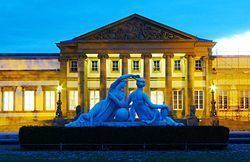Status Complete Location Rosenstein Park Opened 1829 Demolished 1944 Construction started 1824 | Type Palace Country Germany Town or city Stuttgart Architectural style Classical architecture Architect Giovanni Salucci | |
 | ||
Former names Die Kahlenstein (German: The Bald Rock) Etymology Die Rosenstein (German: The Rose Rock), for the rock it sits upon. Similar Rosenstein Park, Museum Schloss Rosenstein, State Museum of Natural H, Württemberg Mausoleum, Wilhelm Palais | ||
Rosenstein Castle (German: Schloss Rosenstein) is a palace in Stuttgart, Germany. It was designed in the classical style by the architect and court builder Giovanni Salucci (1769–1845) as the summer palace for King Wilhelm I of Württemberg and was built between 1822 and 1830.
Contents
Today, the building houses that part of the State Museum of Natural History Stuttgart dealing with extant lifeforms.
Participating artists
Artists who participated in the construction and decoration of the palace were as listed below. Key to the abbreviations:
Trivia
References
Rosenstein Palace Wikipedia(Text) CC BY-SA
